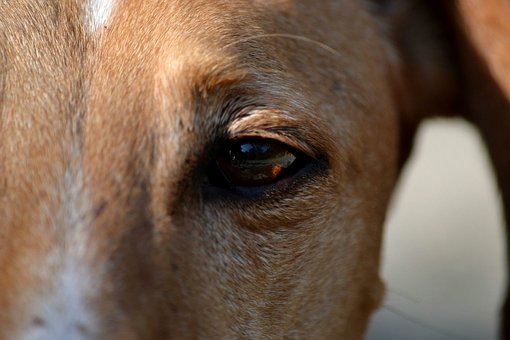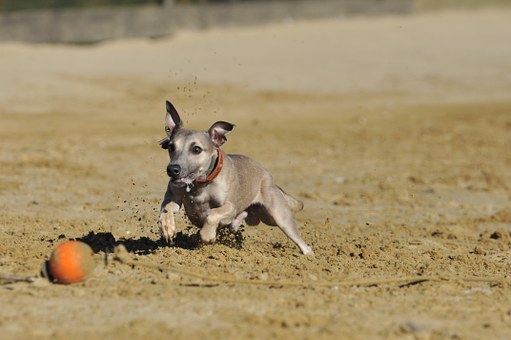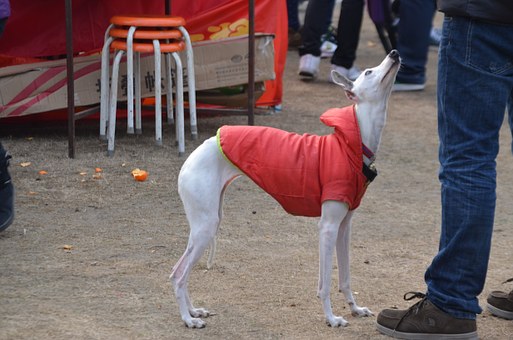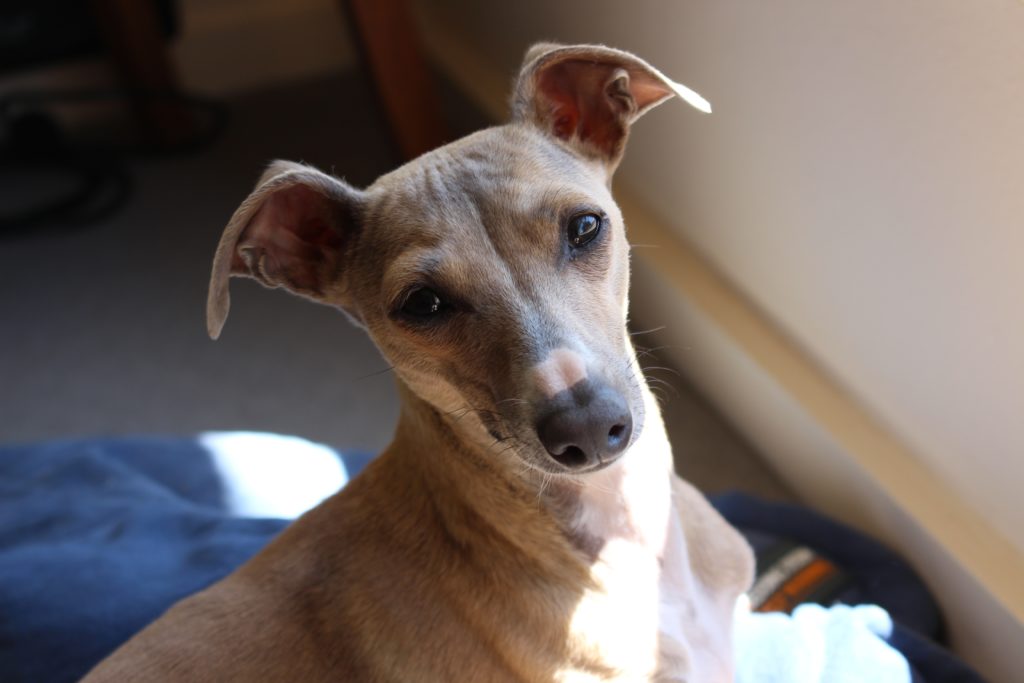The Greyhound has seen a surge in popularity in recent years, in part due to a large effort to adopt retired racing dogs. People are finding that these athletes make great family pets. Part of the reason for the Greyhound’s popularity is their amicable temperament and personality.
Greyhound Breed History
Some of a dog’s temperament is inherited through thousands of years of breed practices. The current Greyhound temperament, however, does not totally match up with what the dogs were used for in years past.
Greyhounds are depicted in cave painting and ancient Egyptian hieroglyphics and are thought to have been used as hunting dogs. The breed became very popular much later in 18th century England and actually came to be a sign of nobility.
At their roots, the Greyhound is an intelligent, calm, quiet, sometimes shy, and graceful dog that also happens to be one of the fastest animals on the planet. Because of their speed, they were used to chase down animals such as rabbit, which was a popular menu item in past times. Their speed also made them attractive to the racing industry, and Greyhound racing became popular here in the U.S.
Many tracks have shut down in recent years, or been phased out due to inhumane practices with the animals. Because of this, activist groups and Greyhound rescue organizations have made a big effort to put the retired race dogs into good homes. They are ideal pets because of how low maintenance they are, and their quiet and affectionate nature. In fact, they don’t even need much exercise to be happy.
Greyhound Exercise Requirements

You might think that a dog used to racing around the track would require a lot of time to run, but this actually isn’t true. You don’t need to be a runner yourself to bring a Greyhound home.
The Greyhound is really quite the couch potato and will be happy to be lazy with his family. They also make great apartment dogs, as they will lounge around all day while you are off at work.
While they are built for speed, Greyhounds are not the most energetic dogs and have little to no endurance. All a Greyhound requires as far as exercise is a good daily walk to stretch his legs.
They will appreciate some time to run off leash, but they don’t have a lot of energy that they need to burn off. They can run a few sprints and then be done for the day.
A fenced-in yard will be ideal, as the Greyhound has a strong instinct to chase small animals. They have incredible vision and will take off if something catches their eye. And if they do, you have no chance of catching them. Taking them to the agility track or trying lure training will be good outlets to help your Greyhound get some running in.
For the most part, Greyhounds will be content curling up next to you on the couch, although they can be quite long and lanky animals.
Strong Urge To Chase
Like all other sighthounds, the Greyhound will have a strong urge to chase small animals. This might be a problem if you have other small animals in your home and the dog has not been properly socialized, however, some will have less of a drive to chase prey than others. However, you will need to keep your Greyhound under constant supervision around your other small pets, because instinct can often overcome training, and something bad can happen in an instant.
Greyhounds with strong prey instincts will focus on nothing but whatever small animal catches their attention. The dog will focus on tracking down the animal and won’t hear you calling to come back. They’ll even jump fences or dash across busy roads to get to their prey, which is why they must be kept on a leash at all times. Greyhound puppies will require more activity than retired race dogs, but they will still have the urge to chase, even at a young age, so they will need to be let loose in a safe area.
For this reason, Greyhounds traditionally wear basket muzzles when they are out in public. If they do catch something, they wouldn’t be able to cause any harm. If you bring your Greyhound to the dog park, make sure there are separate areas for big and small dogs.
The Greyhound Temperament

The temperament of a Greyhound is influenced by several factors, including heredity, socialization, and training. Behavioral inheritance is much less predictable than physical traits, and can often be shaped by the environment around them. That being said, there are some traits that are commonly associated with the breed.
Greyhounds are often thought of as big cats because of how lazy they tend to be, and for their intelligence and independence. Greyhounds and other sighthounds are very independent thinkers who aren’t exactly desperate to please you like some other breeds are known for.
If a Greyhound doesn’t want to do something, it will be hard to get this breed to budge, and sometimes they will even get low and refuse to move. Consistent training and positive encouragement will teach them that they need to listen to you when you give a command.
Emotional Sensitivity
Positivity must be stressed, as Greyhounds are also very sensitive animals. They will become timid and shy if they are mistreated, and are prone to high levels of stress if there is tension in your home. Greyhounds are so sensitive that they have been known to vomit if there are loud arguments around them.
A Greyhound will also do best in a quiet, peaceful home. Loud, overly active families may be too much for these dogs. When training a Greyhound, make sure to not react harshly to your dog if he isn’t performing a behavior as you’d like. Be positive and patient, and he will come around.
Socializing Your Shy & Reserved Greyhound
The quiet Greyhound is a rather shy animal that is nervous around strangers and other animals unless he has been properly socialized. If you get your Greyhound as a puppy, start socializing him right away so they can grow confidence around new people and animals as well as in unfamiliar places.
When learning how to socialize your dog, he will huddle close to you and will almost never approach a stranger, but your pup can become more comfortable with new people if he sees you interacting with them. You should take your dog to new places to experience new sights and sounds and get him used to being in unfamiliar places. If your dog doesn’t get out to meet animals and experience new surroundings, you will have a very timid animal that is wary of strangers and other dogs.
If you adopt an adult Greyhound, you may have a tougher time, as they often are kept in crates when not racing and have only ever seen other Greyhounds. Any other breed of dog or animal will be a totally new experience for them. Their overall temperament may not change much, but you can help the dog be less nervous in these situations by taking them out and meeting other dogs and people frequently. Gently encourage the dog to engage with other animals and people and reward them for doing so.
Overall, the Greyhound has a great temperament that would be a good fit for most families, young and old. They are gentle animals that make great companions as long as they are able to coexist with you and your family peacefully.
Greyhounds & Children

How a Greyhound will act around children mostly depends on the individual dog. Because Greyhounds are so sensitive, children can be quite overwhelming for them due to their tendency to scream and play a little too rough.
Children need to learn to understand a dog’s boundaries, but if they don’t they may just end up stressing your Greyhound.
Greyhounds are not aggressive and you typically won’t have to worry about them snapping at your children, they usually will just walk away if the child is bothering them.
But overall, Greyhounds may be best suited for homes without small children so as to not stress them out.
Are Greyhounds Aggressive?
Despite appearing to be ferocious when they are tearing down a track, Greyhounds are non-aggressive dogs that tend to freeze up when they are challenged or attacked. They may even startle if they are touched unexpectedly, so they will require a gentle hand during training and calm, positive commands. They need a lot of praise and affection to want to learn anything at all.
Luckily, their total lack of aggression makes them docile animals that almost never bark. If you want a quiet dog who won’t be looking to get into any trouble, they Greyhound might be the one for you.
The Greyhound Personality
The low-maintenance Greyhound is a gentle, sensitive dog who is very loving to his family. They are known for being incredibly quiet and lazy, with their favorite activity being none at all. People unfamiliar with the breed are often surprised at how calm Greyhounds are because their only association with the breed is being an athlete racer.
Large Lap Dogs
Despite being fairly large dogs, they will love nothing more than to hop up on the couch and lay their heads on your lap, hoping for a good scratch or belly rub. You will most often find this breed lounging around your home, making them perfect for city and apartment life. They are also very clean animals, and despite not being the best with obedience training, they will generally follow your commands, as long as you have made it clear that you are their leader.
Despite their docile and quiet nature, they are still tall, strong, and powerful dogs, that can bolt after another animal if their instinct to chase is triggered. They will need to be kept on a leash at all times when outside and may take some time to get used to other small animals in the house.
Greyhound Personality Traits – Retired Racers

Retired race dogs come with an almost totally different set of personality traits than a puppy who comes from a breeder. If you are choosing to adopt a Greyhound, here are a few things you should be aware of.
Separation Anxiety
Retired racing Greyhounds are very susceptible to separation anxiety because they have spent their entire life living in a kennel with plenty of company from other racing dogs. They can become easily stressed when left alone in your home, simply because they have never been alone before.
If you are adopting a retired racer, it may be best to get two, but if that seems like too much, try to leave him activities during the day, such as a Kong stuffed with some treats. This breed will also actually be most comfortable staying in a crate while you are gone since it is what they are used to.
Adaptability To New Situations
An adult retired race dog may actually take some more time to get used to new situations and surroundings than a puppy. This is because they are so used to being kept in a kennel or crate and sometimes transported between tracks. They are kept on strict schedules and may have little to no variation in their daily routine.
An issue that may arise is the fact that many Greyhounds have never seen another breed of dog before, so their behavior around new animals may be a bit unpredictable. They are not known to be aggressive but are prone to high stress, so they may need to be introduced to new situations and animals slowly, rather than all at once. This may be the best course of action to maintain a calm dog rather than one who becomes nervous and unstable because of how much you are throwing at them.
Another potential advantage of adopting a retired racer is that you already know what the dog’s temperament is, whereas a puppies will develop over time. An adult may change slightly while adapting to their new situation, but for the most part, their personality and temperament are already set in stone.




